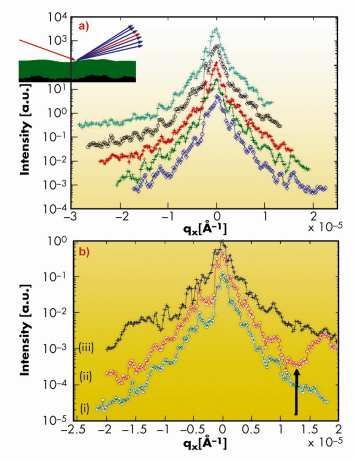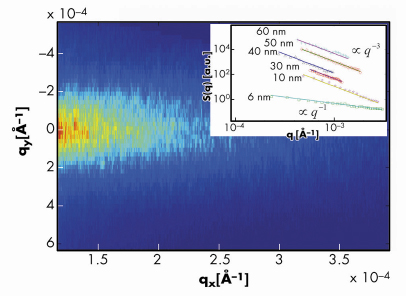- Home
- Users & Science
- Scientific Documentation
- ESRF Highlights
- ESRF Highlights 2007
- Soft Condensed Matter
- Thin liquid films in coherent X-ray light
Thin liquid films in coherent X-ray light
Adsorption and wetting of fluids on solid substrates are phenomena of long-standing interest in fundamental research. Since they determine the homogeneity of thin films and coatings, they also have a technological interest. Solid substrates exposed to a vapour atmosphere attract molecules from the gas phase leading to the formation of a thin liquid film with a thickness of a few nanometres. Such nanofilms are not only omnipresent in everyday life but they also provide a model system for studying properties of thin liquid films.
Thick films and bulk liquids display fluctuating surface contours driven by the thermal motion of molecules underneath the surface. However, the dynamical properties of thin films are strongly influenced by the interaction with the substrate and a rich variety of phenomena like correlated surface roughness and slowing down of surface fluctuations are expected. Moreover, in thin films, surface fluctuations are known to influence the early stages of dewetting processes.
Coherent X-rays are ideal for the investigation of thin liquid films as the corresponding speckle structure allows one to measure the exact arrangement of the surface contour as well as possible dynamical fluctuations. In experiments at ESRF beamline ID10A and APS beamline 8ID, silicon wafers were exposed to the gas phase of the highly volatile liquid n-hexane. The liquid molecules can be condensed on the substrate by lowering the substrate temperature slightly. In this way film thicknesses from monolayer coverage up to 80 nm have been prepared and investigated.
Figure 51a shows the static speckle structure of slowly-grown thin liquid films obtained by in situ rocking curves. The data represent scattering from the empty substrate, and films of thicknesses 3, 6, 10 and 14 nm. A comparison of the speckle structure yields direct information about the transfer of surface structures from the substrate to the liquid film. In the case of slow condensation the speckle structures of the liquid films are similar while not absolutely identical to that of the underlying substrate, implying that the surface structure of the liquid film is following the substrate. The degree of replication however depends on the deposition rate of the molecules on the substrate. Figure 51b displays the corresponding speckle structures for rapid condensation (i.e. 12 nm, within 1-2 minutes). Curve (i) represents the speckle structure from a 3 nm thick film. Curve (ii) is the repeated scan with a sudden decrease of the substrate temperature indicated by the position of the arrow. The resulting fast condensation of molecules immediately leads to a different surface structure as can be seen by the speckle structure. The surface structure of the final 15 nm thick film (curve (iii)) is completely different from the initial substrate surface.
 |
|
Fig. 51: Rocking scans of vapour deposited thin liquid hexane films on silicon substrates. a) Empty substrate and slowly grown films of thickness 3, 6, 10, and 14 nm – from bottom to top. b): Rapidly grown films (i) 3 nm thick film (ii) repeated scan, the arrow indicates rapid condensation (iii) 15 nm thick film. |
Figure 52 shows an averaged CCD image of a 40 nm thick hexane film. Again a static speckle pattern is visible indicating that the film displays no surface dynamics. The inset shows the ensemble averaged static structure factor S(q) of films of different thickness. For all but the thinnest film (6 nm) we observed the peculiar form S(q) ~ q–3 which suggest a self-affine fractal surface structure with a universal scaling exponent H=0.5 for the liquid films. This self-affine surface structure indicates a partial wetting situation.
 |
|
Fig. 52: Average CCD image from the scattering of a 40 nm thick hexane film on silicon. Inset: The ensemble averaged static structure factor S(q) for films of different thickness. |
The results reveal a more complex behaviour of thin liquid films than previously anticipated. Instead of a fluctuating surface contour induced by capillary waves, static surface structures were observed on length scales ranging from 106 Å to 103 Å. The experiments have been performed at temperatures far above the freezing point of bulk hexane; This suggests a different mechanism than solidification through freezing. Capillary waves are caused by long ranging, collective motion of molecules on length scales ranging from mm to nm. Partial wetting leads to a non-uniform film which causes classical hydrodynamics, as expressed by the Navier-Stokes equations, to be no longer valid on the probed length scales. The result is that the thin liquid films behave like solid matter on these length scales. This behaviour is visible in the diffuse scattering with a characteristic form of the power spectral density which is usually not seen on liquid surfaces and indicates a self-affine fractal surface structure with a correlation length larger than 3000 Å.
Principal publication and authors
C. Gutt (a), M. Sprung (b), R. Fendt (c), A. Madsen (d), S.K. Sinha (e) and M. Tolan (c), Phys. Rev. Lett., 99, 096104 (2007).
(a) Hasylab/DESY, Hamburg (Germany)
(b) Argonne National Laboratory, Chicago (USA)
(c) Universität Dortmund (Germany)
(d) ESRF
(e) UCSD, San Diego (USA)



